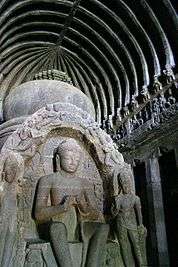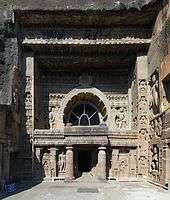Kanheri Caves
| Kanheri Caves | |
|---|---|
| कान्हेरी लेणी (Marathi) | |
|
Unfinished prayer hall and Stupa in cave 03 | |
| Location | Sanjay Gandhi National Park |
| Coordinates | 19°12′30″N 72°54′23″E / 19.20833°N 72.90639°ECoordinates: 19°12′30″N 72°54′23″E / 19.20833°N 72.90639°E |
| Geology | Basalt |
| Entrances | 109 |
The Kanheri Caves (Sanskrit: कान्हेरीगुहाः Kānherī-guhāḥ) are a group of caves and rock-cut monuments formed from a massive basalt outcrop in the forests of the Sanjay Gandhi National Park, on the western outskirts of Mumbai, India. They contain Buddhist sculptures and relief carvings, paintings and inscriptions, dating from the 1st century BCE to the 10th century CE. Kanheri comes from the Sanskrit Krishnagiri, which means black mountain.[1][2]
Description

The site is on a hillside, and is accessed via rock cut steps. The cave complex comprises one hundred and nine caves, carved from the basalt rock and dating from the 1st century BCE to the 10th century CE. The oldest are relatively plain and unadorned, in contrast to later caves on the site, and the highly embellished Elephanta Caves of Mumbai. Each cave has a stone plinth that functioned as a bed. A congregation hall with huge stone pillars contains a stupa (a Buddhist shrine). Rock-cut channels above the caves fed rainwater into cisterns, which provided the complex with water.[3] Once the caves were converted to permanent monasteries, their walls were carved with intricate reliefs of Buddha and the Bodhisattvas. Kanheri had become an important Buddhist settlement on the Konkan coast by the 3rd century CE.[4]
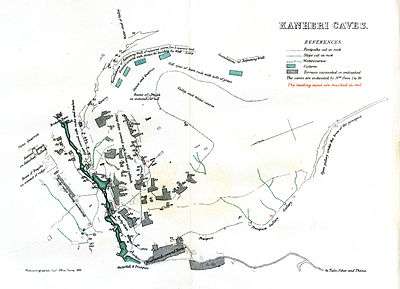
Most of the caves are used as the Buddhist viharas, meant for living, studying, and meditating. The larger caves, which functioned as chaityas, or halls for congregational worship, are lined with intricately carved Buddhist sculptures, reliefs, pillars and rock-cut stupas. The Avalokiteshwara is the most distinctive figure. The large number of viharas demonstrates the well organized establishment of Buddhist monks. This establishment was also connected with many trade centers, such as the ports of Sopara, Kalyan, Nasik, Paithan and Ujjain. Kanheri was a University center by the time the area was under the rule of the Maurayan and Kushan empires.[1] In the late 10th century, the Buddhist teacher Atisha (980–1054) came to the Krishnagiri Vihara to study Buddhist meditation under Rahulagupta.[5]
Inscriptions at Kanheri
Nearly 51 legible inscriptions and 26 epigraphs are found at Kanheri, which include the inscriptions in Brahmi, Devanagari and 3 Pahlavi[6] epigraphs found in Cave 90.[1][7] One of the significant inscriptions mentions about the marriage of Satavahana ruler Vashishtiputra Satakarni with the daughter of Rudradaman I.[8]
A 494-495 CE inscription found at Kanheri mentions the Traikutaka dynasty.[9]
Paintings in the caves
Cave number 34 has unfinished paintings of Buddha on the ceiling of the cave.
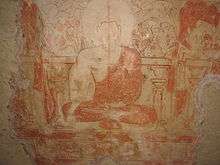
| Pilgrimage to |
| Buddha's Holy Sites |
|---|
 |
| The Four Main Sites |
| Four Additional Sites |
| Other Sites |
| Later Sites |
 The caves as viewed from the base of the hill
The caves as viewed from the base of the hill Rock cut stair leading to Kanheri
Rock cut stair leading to Kanheri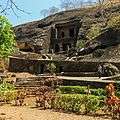 Main entrance to the caves
Main entrance to the caves Cave 1
Cave 1 Cave 3
Cave 3 Spartan plinth beds
Spartan plinth beds Vihara - prayer hall
Vihara - prayer hall A vihara
A vihara Kanheri Caves served as a center of Buddhism in Western India during ancient times
Kanheri Caves served as a center of Buddhism in Western India during ancient times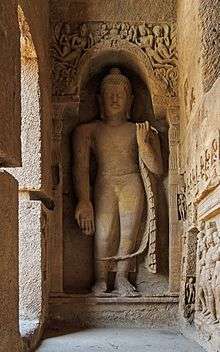 Sculpture of Buddha in a temple at Kanheri Caves
Sculpture of Buddha in a temple at Kanheri Caves Cave sculpture of Buddha
Cave sculpture of Buddha
References
- 1 2 3 "Kanheri Caves". Retrieved 2007-01-28.
- ↑ Rajen Noir (2006-10-31). "Mumbai's Ancient Kanheri Caves". Retrieved 2007-01-31.
- ↑ "Mumbai attractions". Archived from the original on 2007-11-09. Retrieved 2007-01-28.
- ↑ "Kanheri Caves Mumbai". Retrieved 2007-01-31.
- ↑ Ray, Niharranjan (1993). Bangalir Itihas: Adiparba in Bengali, Calcutta: Dey's Publishing, ISBN 81-7079-270-3, p. 595.
- ↑ West, E.W. (1880). "The Pahlavi Inscriptions at Kaṇheri". The Indian Antiquary. 9: 265–268.
- ↑ Ray, H.P. (2006). Inscribed Pots, Emerging Identities in P. Olivelle ed. Between the Empires: Society in India 300 BCE to 400 CE, New York: Oxford University Press, ISBN 0-19-568935-6, p.127
- ↑ "A Note on Inscriptions in Bombay". Maharashtra State Gazetteers-Greater Bombay District. Government of Maharashtra. 1986. Retrieved 2012-11-23.
- ↑ Geri Hockfield Malandra (1993). Unfolding A Mandala: The Buddhist Cave Temples at Ellora. SUNY Press. pp. 5–6. ISBN 9780791413555.
Further reading
| Wikimedia Commons has media related to Kanheri Caves. |
- Nagaraju, S. (1981). Buddhist Architecture of Western India, Delhi: Agam Kala Prakashan.
External links
- Walking through the Historical Timeline of Buddhism
- Kanheri Caves
- Kanheri Caves Decoded is an online documentary video
- A detailed Review of Kanheri Caves and Sanjay Gandhi National Park: Read this before you go.

